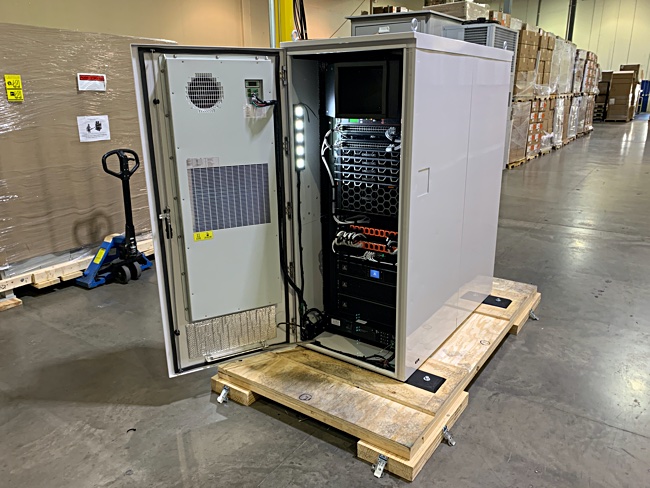Dell EMC has announced a rack-in-a-box mini data centre, complete with new Streaming Data Platform software to store and analyse incoming data.
The Modular Data Centre Micro 415 puts a populated data centre rack inside an extreme temperature-resistant enclosure, with key lock doors, power, cooling, and remote management. There is an option for smoke detection and fire suppression.
The edge system can sit in a car park and act as a concentrator storage and processing box for locally generated data that needs analysing and acting upon faster than a remote on-premises or public cloud data centre can deliver.

Dave McCarthy, IDC research director for edge strategies, provided the obligatory analyst quote: “Edge computing will become a critical element for most every enterprise looking to gain business insights and competitive advantage.”
The Micro 415 box can be populated with new PowerEdge XE2420 servers. These two-socket systems can handle the incoming data streams and crunch the data and they have the flexibility to add up to four accelerators and 92TB of storage.
Management and monitoring is provided by the new Dell Remote Access Controller, iDRAC 9 Datacenter, which supports remote deployment and streaming telemetry.
Streaming Data Platform
Incoming data from devices feeding the 415 is handled by Dell EMC’s new Streaming Data Platform (SDP) software. This is cloud-native software requiring Kubernetes orchestration. It uses Apache Flink and Pravega components, and has elastic 2-tiered storage providing “instant access to data and infinite storage and access to historical data”.
Open source Pravega is a stream store built to handle large amounts of continuously arriving data. It handles ingestion and storage for all types of streams, including continuously streaming unbounded byte streams.
Flink is an open source software project and Dell EMC distributes the Ververica Flink enterprise version of Flink as its supported embedded analytics engine. Customers can develop Pravega software connectors or use community connectors that integrate with other engines.

The Streaming Data management platform is proprietary Dell EMC software. It integrates the other components and adds security, performance, configuration, and monitoring features. There is a web-based UI for administrators, application developers, and data analysts.
This management platform runs in a Kubernetes container environment that isolates projects, manages resources, and provides authentication and RBAC (role-based access control) services. The verified container environment is Pivotal Container Services (PKS), which is a Kubernetes service provider and deploys an instance of Kubernetes.
SDP runs on a reference hardware platform for processing and elastic scale-out storage capacity for tier 1 storage. Details of this were not available at announcement time but we’re thinking of NVMe SSDs inside a Dell server.
Persistent tier 2 scale-out storage is provided by an Isilon cluster. Tier 2 storage may be a file system for test and dev, or for use cases where only temporary storage is needed. This can be a local mount or an NFS mount point.
Pravega event data streams are durable, ordered, consistent, and transactional. The software coordinates a two-tiered storage system for each incoming stream.
- Tier 1 stores the recently ingested tail of a stream temporarily.
- Tier 2 places ingested data into the Isilon long-term storage.
Users can configure data retention periods.
Availability
The PowerEdge XE2420 begins initial availability in the second quarter of 2020 and the Modular Data Center Micro is slated to make its public debut in the second half of 2020.
The iDRAC9 Datacenter and the Streaming Data Platform are available globally today.
Comment
In concept the Modular Data Centre Micro 415 is a scaled down version of Sun’s original 2006-era containerised data centre. That box was copied by Dell in 2008. It now appears that rack-in–box units might be more popular. We expect other server vendors, such as Cisco, HPE, Lenovo and Supermicro, to follow in Dell EMC’s footsteps. Also, Dell’s “infinite storage” claim is logically impossible in a bounded enclosure. Therefore we anticipate the company will build public connectivity to a third tier of storage, making it easier to justify this claim.







